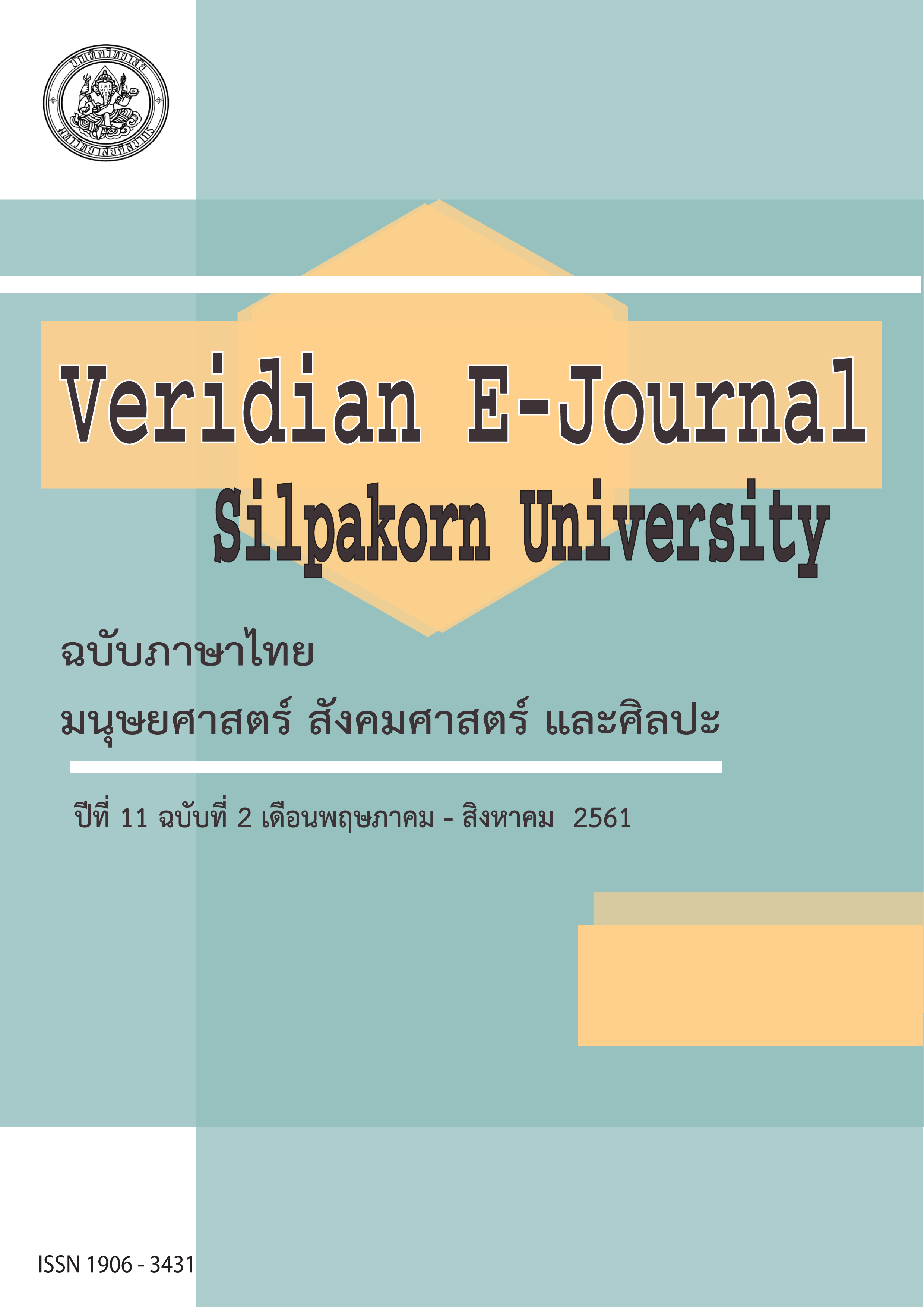การพัฒนาอัตลักษณ์องค์กรสมาร์ตฟาร์มเมอร์ (Smart Farmer) ด้วยวิธีบูรณาการ การวิจัย การบริการวิชาการและการเรียนการสอนอย่างมีส่วนร่วม ตามแนวคิดเศรษฐกิจดิจิทัล (A developmentof Smart Farmer Corporate Identities by Integrating Research, Academic Service and-) A developmentof Smart Farmer Corporate Identities by Integrating Research, Academic Service and Participatory Learning, According to Digital Economy
Main Article Content
Abstract
งานวิจัยครั้งนี้ใช้กระบวนการวิจัยแบบมีส่วนร่วม (Participatory Action Research - PAR) มีจุดมุ่งหมายเพื่อออกแบบและพัฒนาอัตลักษณ์องค์กรให้กับผู้ประกอบการสมาร์ทฟาร์มเมอร์ จำนวน 4 ฟาร์ม รวมถึงบูรณาการกระบวนการวิจัย การบริการวิชาการและการเรียนการสอน ยังผลให้นักศึกษาได้เรียนรู้กระบวนการออกแบบอัตลักษณ์องค์กรด้วยกระบวนการวิจัย โดยผู้มีส่วนร่วมในงานวิจัยได้แก่ 1)ผู้ประกอบการ 2) ทายาทผู้ประกอบการ 3) ลูกค้าประจำ 4) นักศึกษาออกแบบ 5) นักวิชาการด้านการออกแบบ 6) พัฒนาชุมชนจังหวัดสมุทรปราการและสภาเกษตรจังหวัดสมุทรปราการ สถิติที่ใช้ในการวิเคราะห์ข้อมูลคือค่าเฉลี่ย ร้อยละ ส่วนเบี่ยงเบนมาตรฐาน และสถิติเปรียบเทียบ In-Dependent T-Test
ผลการวิจัยพบว่า
- ผู้ประกอบการมีความต้องการด้านการพัฒนาภาพลักษณ์รูปแบบบรรจุภัณฑ์ การบูรณาการเทคโนโลยีสารสนเทศและการสื่อสารการตลาดดิจิทัลไปยังกลุ่มผู้บริโภค จุดเด่นจุดด้อยโอกาสและอุปสรรคของผู้ประกอบการ 1)จุดเด่นคือ ผู้ประกอบการมีความรู้ด้านการเพาะเลี้ยงสัตว์น้ำอย่างดี 2)จุดด้อยคือ ปัญหาการพัฒนาผลิตภัณฑ์ ไม่มีความรู้ด้านการใช้เทคโนโลยีและการสื่อสารการตลาด และไม่มีความรู้ด้านการบริหารจัดการฟาร์ม 3)โอกาสคือ การเข้าถึงข้อมูลของกลุ่มเป้าหมายได้ง่ายและสะดวก 4)อุปสรรคคือ สภาพเศรษฐกิจโลกที่ถดถอย ขาดต้นทุนและแรงงาน ข้อค้นพบที่โดดเด่นคือ หากผู้ประกอบการไม่สนใจและไม่เปิดรับเทคโนโลยีดิจิทัล เช่น ไม่ใช้เครือข่ายสังคมออนไลน์ Facebook หรือ Line การให้ความรู้ด้านการใช้เทคโนโลยีดิจิทัลจะไม่สัมฤทธิ์ผล
- การออกแบบอัตลักษณ์องค์กรอย่างมีส่วนร่วมด้วยแนวคิดเศรษฐกิจดิจิทัลคือ การออกแบบอัตลักษณ์ที่สะท้อนภูมิปัญญาและวัฒนธรรม ให้มีความเป็นสากล ทันสมัยและมีศักยภาพเพื่อการแข่งขันกับต่างชาติได้ อีกทั้งการออกแบบอัตลักษณ์องค์กรและสื่อออนไลน์ตามแนวคิดเศรษฐกิจดิจิทัล ต้องสะท้อนความคิดเห็นและความต้องการของผู้มีส่วนได้ส่วนเสียกับงานออกแบบอย่างเป็นประชาธิปไตย ใช้สัญลักษณ์ที่สื่อความหมายเชื่อมโยงกับผู้ประกอบการ สถานที่ตั้ง หรือเอกลักษณ์ของฟาร์ม ใช้ตัวอักษรที่อ่านง่าย ขนาดเหมาะสมกับกลุ่มเป้าหมาย เลือกใช้สีที่น่าสนใจและสร้างการจดจำได้ดี ดังนั้นควรเลือกใช้สีที่สะท้อนผลิตภัณฑ์หรือองค์กร ข้อค้นพบที่โดดเด่นคือ การออกแบบอัตลักษณ์องค์กรอย่างมีส่วนร่วมช่วยกระตุ้นให้ผู้ประกอบการที่คิดเลิกล้มกิจการกลางคัน มีกำลังใจที่จะฝ่าฟันอุปสรรคต่อไป เนื่องจากได้มองเห็นงานอย่างเป็นรูปธรรมและได้ร่วมวางแผนการพัฒนาผลิตภัณฑ์ของตนเอง รู้สึกอบอุ่นเหมือนมีพี่เลี้ยง ทำให้เกิดการยอมรับในผลงานออกแบบส่งผลให้ผู้ประกอบการนำผลงานออกแบบไปจดทะเบียนเครื่องหมายการค้า
- การออกแบบอย่างมีส่วนร่วมทำให้นักศึกษาพัฒนาทักษะความเป็นนวัตกรมากขึ้น กล่าวคือนักศึกษามีความสามารถและทักษะที่จำเป็นต่อการพัฒนานวัตกรรม ได้แก่ มีทักษะด้านการออกแบบและสร้างสื่อดิจิทัล มีจิตอาสาช่วยเหลือชุมชน สามารถการสร้างเครือข่ายกับชุมชน สามารถตั้งคำถามระหว่างการวิจัย สามารถคิดเชื่อมโยงความต้องการของผู้มีส่วนร่วมกับงานออกแบบอัตลักษณ์องค์กร ฝึกสังเกตภาษากายและข้อความต่าง ๆ ได้เป็นอย่างดี การบูรณาการกระบวนการวิจัยกับการเรียนการสอนยังผลให้นักศึกษาเกิดการเปลี่ยนแปลงด้านการเรียนรู้ ความเข้าใจและทักษะการเป็นผู้นำด้านนวัตกรในยุคดิจิทัลเพิ่มขึ้นหลังเรียนรู้อย่างชัดเจน โดยส่วนที่เพิ่มขึ้นด้านประเด็นความรู้ ความเข้าใจเกี่ยวกับการบูรณาการงานวิจัย การเรียนการสอน การบริการวิชาการมากที่สุด 3 ลำดับแรกได้แก่ 1) มีความรู้ด้านการออกแบบเครื่องมือวิจัย (t=10.96*) 2) มีความรู้เกี่ยวกับผลิตภัณฑ์เกษตรชุมชน (สมาร์ตฟาร์เมอร์) (t=8.59*) และ 3) มีความรู้ด้านการวิเคราะห์ แปรผล และสรุปข้อมูลวิจัย (t=7.90*) ในส่วนของประเด็นความรู้ความเข้าใจเกี่ยวกับความเป็นนวัตกรเศรษฐกิจดิจิทัล มากที่สุด 3 ลำดับแรกได้แก่ 1) มีความรู้ด้านการสร้างสื่อดิจิทัล (t=8.36*) 2) มีความรู้เกี่ยวกับแนวคิดเศรษฐกิจดิจิทัล (t=7.67*) และ 3) มีทักษะด้านการเชื่อมโยงข้อมูล (t=7.45*)
This research used a Participatory Action Research (PAR) and aimed to design and develop enterprise identity of the Smart Farmers totaling four farms which including the integration research process, academic service, and teaching methodology. Students learned how to design enterprise identity with the research process. The participants in the study were: 1) Entrepreneurs 2) Descendant Entrepreneurs 3) Customers 4) Student 5), Academic Designers 6) Community Development and the Farmers Council of Samut Prakan province. The statistics used in data analysis were mean, standard deviation, and independent t-test.
The results of this study indicated that:
- Entrepreneurs needed to develop the appearance of packaging. The integration of information technology and digital communication through consumers, there were strengths and weaknesses, opportunities and threats of entrepreneurs. 1) Strengths: the entrepreneurs had knowledge of aquaculture well. 2) Weaknesses: there was not enough knowledge on technology and marketing communication to develop a product and farm management 3) Opportunities: easy and convenient to reach the target audience. 4) Threats: The world economic downturn, lack of capital and labor. The outstanding result was that even if entrepreneurs did not expose to digital technologies such as not using online social networks like a Facebook or Line, providing knowledge how to use digital technology would not be completed.
- Enterprise identity as part of the Digital Economy concept was designed to reflect the intellectual and cultural identities. There was universal, up-to-date, and potential for an international competition. In addition, the design of enterprise identity and online media as the digital economy had to reflect the democratic needs of stakeholders. Using symbolic meanings was associated with the entrepreneurs, location, or identity of the farm. Using legible font sizes was appropriate to the target audience. Selecting attractive colors and offering good retention. Therefore, selecting colors reflects to the product or organization. The outstanding result in this study was the design of enterprise identity assists encouraging entrepreneurial thinking abandoned midstream business to continue to overcome obstacles. Since, this could be seen and has developed its own products. This also felt warm in the design. It would be accepted in the operator and registered trademarks.
- Participatory design engaged students to develop more skills as innovators.The students had the ability and necessary skills to develop innovative skills such as creating digital media, volunteering community, networking with the community, asking research question, linking the idea with entrepreneur identity, observing body language and messages as well. Furthermore, the integrating research and teaching had an effect for the students’ change in their learning and understanding the leading innovators in the digital age. The knowledgeable increase after learning, understanding about the integrating research, teaching methodology, and academic service were at the first three ranks as follows: 1) Designing research instruments (t = 10.96*), 2) knowing about the agricultural community products. (Smart Famers) (t = 8.59*), and 3) interpretation and summary of research (t = 7.90*). For the understanding about the digital economy innovators was at the first three ranks as follows: 1) Creating digital media (T = 8.36*), 2) Knowing about the digital economy (t = 7.67 *), and 3) skills associated information (T = 7.45*).

